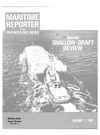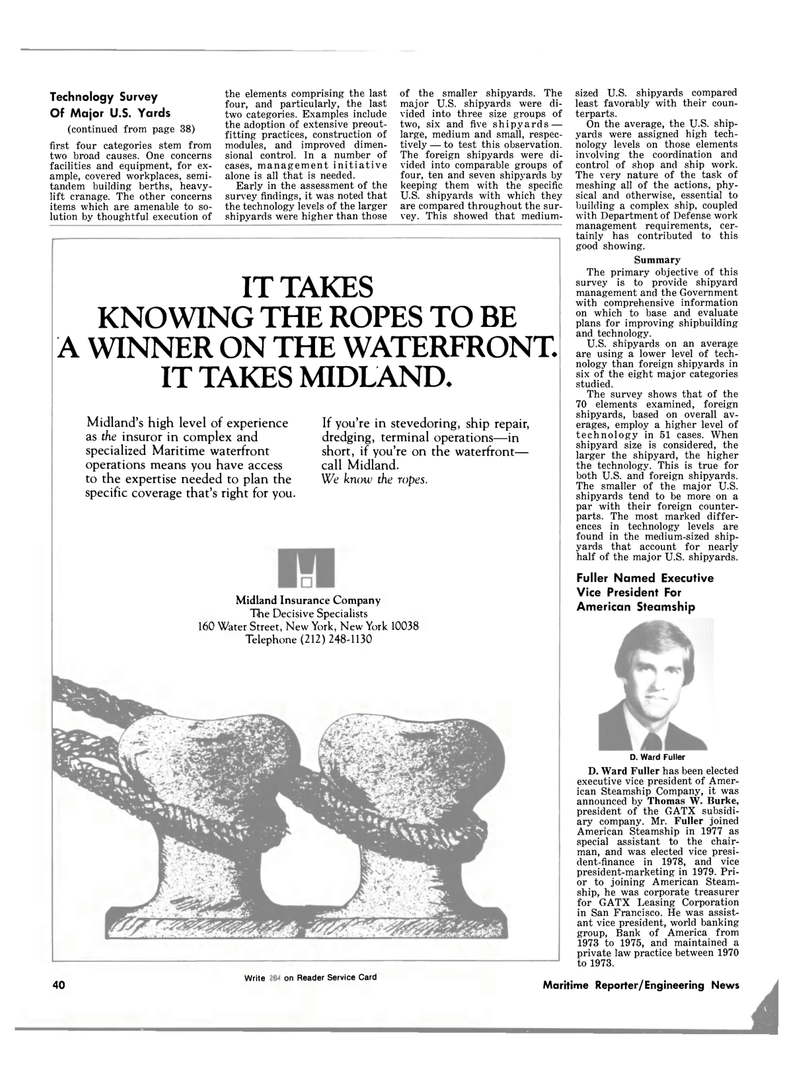
Page 40: of Maritime Reporter Magazine (January 1981)
Read this page in Pdf, Flash or Html5 edition of January 1981 Maritime Reporter Magazine
Technology Survey
Of Major U.S. Yards (continued from page 38) first four categories stem from two broad causes. One concerns facilities and equipment, for ex- ample, covered workplaces, semi- tandem building berths, heavy- lift cranage. The other concerns items which are amenable to so- lution by thoughtful execution of the elements comprising the last four, and particularly, the last two categories. Examples include the adoption of extensive preout- fitting practices, construction of modules, and improved dimen- sional control. In a number of cases, management initiative alone is all that is needed.
Early in the assessment of the survey findings, it was noted that the technology levels of the larger shipyards were higher than those of the smaller shipyards. The major U.S. shipyards were di- vided into three size groups of two, six and five shipyards — large, medium and small, respec- tively — to test this observation.
The foreign shipyards were di- vided into comparable groups of four, ten and seven shipyards by keeping them with the specific
U.S. shipyards with which they are compared throughout the sur- vey. This showed that medium- sized U.S. shipyards compared least favorably with their coun- terparts.
On the average, the U.S. ship- yards were assigned high tech- nology levels on those elements involving the coordination and control of shop and ship work.
The very nature of the task of meshing all of the actions, phy- sical and otherwise, essential to building a complex ship, coupled with Department of Defense work management requirements, cer- tainly has contributed to this good showing.
Summary
The primary objective of this survey is to provide shipyard management and the Government with comprehensive information on which to base and evaluate plans for improving shipbuilding and technology.
U.S. shipyards on an average are using a lower level of tech- nology than foreign shipyards in six of the eight major categories studied.
The survey shows that of the 70 elements examined, foreign shipyards, based on overall av- erages, employ a higher level of technology in 51 cases. When shipyard size is considered, the larger the shipyard, the higher the technology. This is true for both U.S. and foreign shipyards.
The smaller of the major U.S. shipyards tend to be more on a par with their foreign counter- parts. The most marked differ- ences in technology levels are found in the medium-sized ship- yards that account for nearly half of the major U.S. shipyards.
Fuller Named Executive
Vice President For
American Steamship
D. Ward Fuller
D. Ward Fuller has been elected executive vice president of Amer- ican Steamship Company, it was announced by Thomas W. Burke, president of the GATX subsidi- ary company. Mr. Fuller joined
American Steamship in 1977 as special assistant to the chair- man, and was elected vice presi- dent-finance in 1978, and vice president-marketing in 1979. Pri- or to joining American Steam- ship, he was corporate treasurer for GATX Leasing Corporation in San Francisco. He was assist- ant vice president, world banking group, Bank of America from 1973 to 1975, and maintained a private law practice between 1970 to 1973.
IT TAKES
KNOWING THE ROPES TO BE
A WINNER ON THE WATERFRONT
IT TAKES MIDLAND.
Midland's high level of experience as the insuror in complex and specialized Maritime waterfront operations means you have access to the expertise needed to plan the specific coverage that's right for you.
If you're in stevedoring, ship repair, dredging, terminal operations—in short, if you're on the waterfront— call Midland.
We know the ropes.
Midland Insurance Company
The Decisive Specialists 160 Water Street, New York, New York 10038
Telephone (212) 248-1130 40 Write 150 on Reader Service Card Maritime Reporter/Engineering News

 39
39

 41
41
